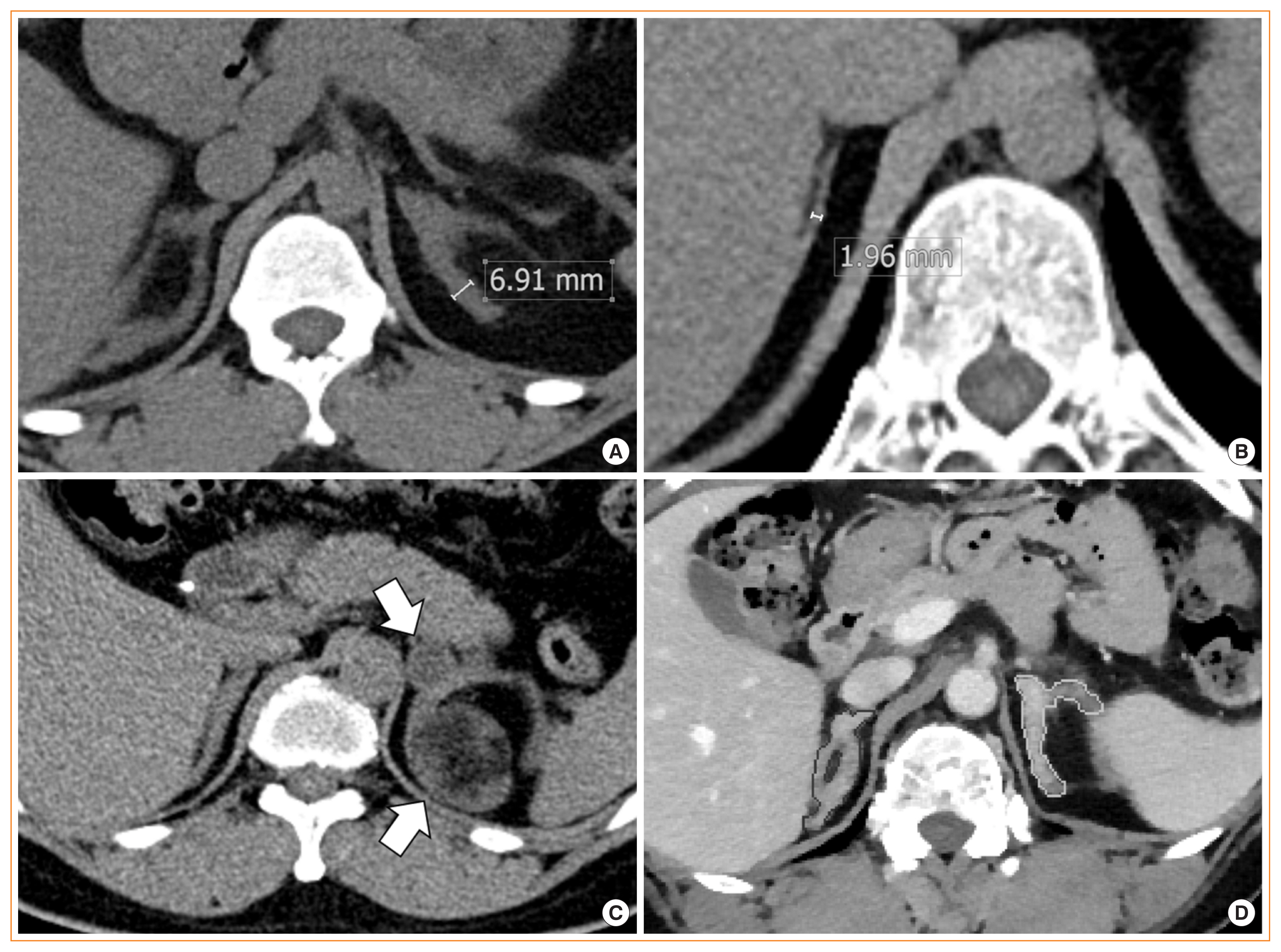Search
- Page Path
- HOME > Search
Original Article
- Adrenal Gland
- Adrenal Morphology as an Indicator of Long-Term Disease Control in Adults with Classic 21-Hydroxylase Deficiency
- Taek Min Kim, Jung Hee Kim, Han Na Jang, Man Ho Choi, Jeong Yeon Cho, Sang Youn Kim
- Endocrinol Metab. 2022;37(1):124-137. Published online February 8, 2022
- DOI: https://doi.org/10.3803/EnM.2021.1278

- 4,269 View
- 126 Download
- 6 Web of Science
- 6 Crossref
-
 Abstract
Abstract
 PDF
PDF PubReader
PubReader  ePub
ePub - Background
Monitoring adults with classical 21-hydroxylase deficiency (21OHD) is challenging due to variation in clinical and laboratory settings. Moreover, guidelines for adrenal imaging in 21OHD are not yet available. We evaluated the relationship between adrenal morphology and disease control status in classical 21OHD.
Methods
This retrospective, cross-sectional study included 90 adult 21OHD patients and 270 age- and sex-matched healthy controls. We assessed adrenal volume, width, and tumor presence using abdominal computed tomography and evaluated correlations of adrenal volume and width with hormonal status. We investigated the diagnostic performance of adrenal volume and width for identifying well-controlled status in 21OHD patients (17α-hydroxyprogesterone [17-OHP] <10 ng/mL).
Results
The adrenal morphology of 21OHD patients showed hypertrophy (45.6%), normal size (42.2%), and hypotrophy (12.2%). Adrenal tumors were detected in 12 patients (13.3%). The adrenal volume and width of 21OHD patients were significantly larger than those of controls (18.2±12.2 mL vs. 7.1±2.0 mL, 4.7±1.9 mm vs. 3.3±0.5 mm, P<0.001 for both). The 17-OHP and androstenedione levels were highest in patients with adrenal hypertrophy, followed by those with normal adrenal glands and adrenal hypotrophy (P<0.05 for both). Adrenal volume and width correlated positively with adrenocorticotropic hormone, 17-OHP, 11β-hydroxytestosterone, progesterone sulfate, and dehydroepiandrosterone sulfate in both sexes (r=0.33–0.95, P<0.05 for all). For identifying well-controlled patients, the optimal cut-off values of adrenal volume and width were 10.7 mL and 4 mm, respectively (area under the curve, 0.82–0.88; P<0.001 for both).
Conclusion
Adrenal volume and width may be reliable quantitative parameters for monitoring patients with classical 21OHD. -
Citations
Citations to this article as recorded by- Long‐term health consequences of congenital adrenal hyperplasia
Riccardo Pofi, Xiaochen Ji, Nils P. Krone, Jeremy W. Tomlinson
Clinical Endocrinology.2023;[Epub] CrossRef - Landscape of Adrenal Tumours in Patients with Congenital Adrenal Hyperplasia
Mara Carsote, Ana-Maria Gheorghe, Claudiu Nistor, Alexandra-Ioana Trandafir, Oana-Claudia Sima, Anca-Pati Cucu, Adrian Ciuche, Eugenia Petrova, Adina Ghemigian
Biomedicines.2023; 11(11): 3081. CrossRef - Multiplexed Serum Steroid Profiling Reveals Metabolic Signatures of Subtypes in Congenital Adrenal Hyperplasia
Jaeyoon Shim, Chang Ho Ahn, Seung Shin Park, Jongsung Noh, Chaelin Lee, Sang Won Lee, Jung Hee Kim, Man Ho Choi
Journal of the Endocrine Society.2023;[Epub] CrossRef - Long-Term Outcomes of Congenital Adrenal Hyperplasia
Anna Nordenström, Svetlana Lajic, Henrik Falhammar
Endocrinology and Metabolism.2022; 37(4): 587. CrossRef - Congenital adrenal hyperplasia in patients with adrenal tumors: a population-based case–control study
F. Sahlander, J. Patrova, B. Mannheimer, J. D. Lindh, H. Falhammar
Journal of Endocrinological Investigation.2022; 46(3): 559. CrossRef - Fully automatic volume measurement of the adrenal gland on CT using deep learning to classify adrenal hyperplasia
Taek Min Kim, Seung Jae Choi, Ji Yeon Ko, Sungwan Kim, Chang Wook Jeong, Jeong Yeon Cho, Sang Youn Kim, Young-Gon Kim
European Radiology.2022; 33(6): 4292. CrossRef
- Long‐term health consequences of congenital adrenal hyperplasia

Review Article
- Reproduction and Metabolism: Insights from Polycystic Ovary Syndrome.
- Prathima Jasti, Andrea Dunaif
- Endocrinol Metab. 2012;27(3):180-190. Published online September 19, 2012
- DOI: https://doi.org/10.3803/EnM.2012.27.3.180
- 2,059 View
- 29 Download
- 2 Crossref
-
 Abstract
Abstract
 PDF
PDF - Until the 1980s, polycystic ovary syndrome (PCOS) was considered to be a poorly defined reproductive disorder. During that decade, it was recognized that PCOS was associated with profound insulin resistance and a substantially increased risk for type 2 diabetes mellitus in young women. Accordingly, the mechanisms linking the reproductive and metabolic features of the syndrome became the subject of intense investigation. Insulin is now recognized as a reproductive as well as a metabolic hormone and insulin signaling in the central nervous system participates in normal reproductive function. These insights have been directly translated into a novel therapy for PCOS with insulin sensitizing drugs. Androgens also have reversible metabolic actions to decrease insulin sensitivity and increase visceral fat. Prenatal androgen administration to non-human primates, sheep and rodents produces reproductive and metabolic features of PCOS suggesting that the disorder also has developmental origins. PCOS is highly heritable and male as well as female relatives have reproductive and metabolic phenotypes. A number of confirmed genetic susceptibility loci have now been mapped for PCOS and genes in well-known as well as novel biologic pathways have been implicated in disease pathogenesis.
-
Citations
Citations to this article as recorded by- The Role of Foxo3 in Leydig Cells
Young Suk Choi, Joo Eun Song, Byung Soo Kong, Jae Won Hong, Silvia Novelli, Eun Jig Lee
Yonsei Medical Journal.2015; 56(6): 1590. CrossRef - FoxO1 Is a Negative Regulator of FSHβ Gene Expression in Basal and GnRH-Stimulated Conditions in Female
Young-Suk Choi, Hyeon Jeong Lee, Cheol Ryong Ku, Yoon Hee Cho, Mi Ran Seo, Yoo Jeoung Lee, Eun Jig Lee
Endocrinology.2014; 155(6): 2277. CrossRef
- The Role of Foxo3 in Leydig Cells


 KES
KES

 First
First Prev
Prev



